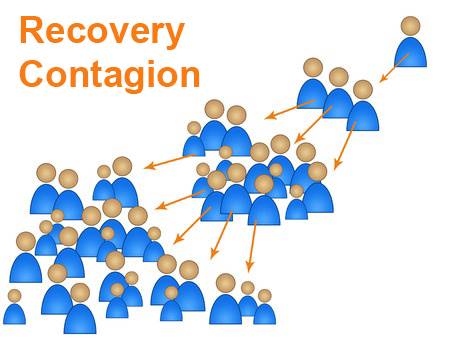
Over the past two centuries, addiction recovery has been understood as primarily an intrapersonal process, though recent decades have witnessed growing interest in the related concepts of family recovery and community recovery. Technologies to promote recovery have targeted the individual with only token interest in interventions in larger social networks. Three provocative discoveries challenge this limited focus: 1) An individual's prognosis for addiction recovery is profoundly influenced by the family and social environment--a point now widely acknowledged but rarely reflected in the clinical treatment of substance use disorders, 2) the resolution of alcohol and other drug (AOD) problems is often a product of social contagion--multiple people within an extended social network simultaneously initiating and maintaining recovery, and 3) the greater the density of recovery carriers within a social milieu, the greater the likelihood other addicted members within that milieu will initiate recovery.
Two fascinating studies confirm the power of social networks as potential recovery catalysts. The first, conducted by Mark Litt and colleagues, examined the effects of changing the social networks of alcohol dependent patients to improve long-term drinking outcomes. They found that adding just one abstinent person to a patient's social network increased by 27% the probability of the patient's abstinence during the next year. A second study by Nicholas Christakis and James Fowler investigated the smoking patterns in a social network of more than 12,000 people over the course of 32 years. They found that one's own chances of continued smoking decreased dramatically when members of one's social network stopped smoking. The odds of smoking decreased 67% if one's spouse stopped smoking, 36% if a friend stopped smoking, 34% if a co-worker in a small firm stopped smoking, and 25% if a sibling stopped smoking. This social influence of smoking cessation extended to three degrees of separation (friends of friend's friends). They concluded: "that smoking behavior spreads through close and distant social tiesAnd thatgroups of interconnected people stop smoking in concert." They went on to suggest that collective interventions may be more effective than individual interventions. The Litt and Christakis and Fowler studies move the potential for addiction recovery from the arena of a personal decision to that of a collective decision shaped by rising social consensus and influence, raising the possibility of recovery cascades (rapid bursts in recovery prevalence) spreading through large social networks.
How could such influence be spread? Three potential strategies are being explored. One, a fledgling social marketing campaign has begun to encourage people in recovery and their family members to share context-appropriate news of their recovery status within their extended family and social networks. Two, cadres of recovery volunteers are being trained to be recovery carriers via recovery messaging training. Three, the prevalence of trained peer recovery coaches and other recovery support specialists is expanding exponentially within a broad spectrum of community service settings.
What have been called contact strategies for combatting social stigma and what has been christened the helper principle (the therapeutic effects of helping others) in the clinical and mutual aid literature may have even greater value in spreading recovery through larger social networks. This would shift recovery from a person-centered clinical outcome to a community-centered public health strategy.
The new story of recovery is a collective rather than a personal story--a "We" story rather than an "I" story. As long as media coverage of addiction focuses almost exclusively on AOD--related deaths and mayhem, isolated stories of personal recovery will always be viewed as moral exceptions to the rule: "Once an addict, always an addict." The goal of the new recovery advocacy movement is not to get a few more personal recovery stories into the public mind. It is instead to tell a much larger "we story"--the story of millions of Americans and other citizens of the world who once faced life-threatening AOD problems but who today live healthy, socially productive, and personally meaningful lives free of such problems. The new recovery advocacy movement is reaching individuals, in part, by making recovery socially contagious. It is achieving such contagion by increasing the social visibility of recovery via living proof of its numerous varieties and styles. It is strategically increasing the density of recovery carriers via its mobilization of people in recovery to serve as advocates and peer helpers. And it is achieving this by expanding the physical and social space the physical and social recovery landscapes--in which recovery can thrive within local communities.
As a field, we are presently so preoccupied with what is going on inside peoples' brains that we are neglecting the recovery-linked power of what is going on in their intimate and social relationships. It is time that power was fully exploited as a public health strategy. That grassroots effort has begun with little recognition from the professional community.